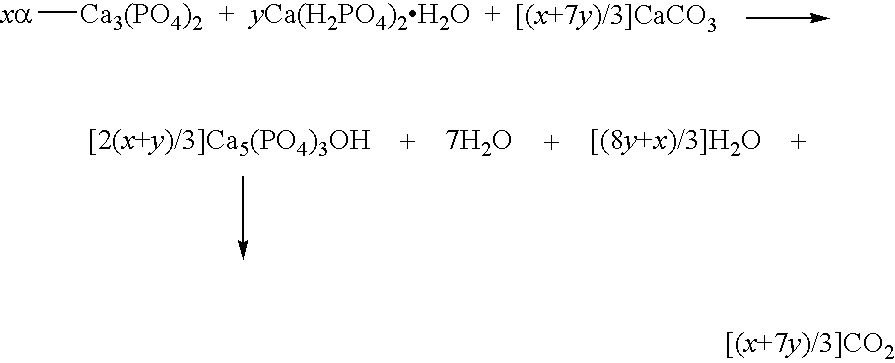Pasty or liquid multiple constituent compositions for injectable calcium phosphate cements
a technology of calcium phosphate cement and multiple constituents, which is applied in the field of injectable bone filling cement, can solve the problems of achieve the effect of simple action and harm to the mechanical properties of cemen
- Summary
- Abstract
- Description
- Claims
- Application Information
AI Technical Summary
Benefits of technology
Problems solved by technology
Method used
Image
Examples
example 1
[0016]Calcium phosphate cement of brushite type presented in the form of two pasty starting constituents.
[0017]The reaction which takes place at the moment of the mixing of the two pastes is as follows:
[0018]
[0019]The pastes can be provided in the following way:[0020]Paste 1:[0021]1.142 g of β-Ca3(PO4)2,[0022]0.636 g of 50 mmol / l Na2H2P2O7 solution[0023]Paste 2:[0024]0.743 g of Ca(H2PO4)2.H2O,[0025]0.322 g of CaSO4.2H2O,[0026]0.514 g of water.
[0027]Plaster CaSO4.2H2O participates in the composition of Paste 2 for ancillary reasons (retarding the setting of the cement, better tolerance of the cement in vivo, and the like).
[0028]It is possible to add, to Paste 1 or 2 or to both, polymeric adjuvants, suspension stabilizers, setting retardants (for example Na2H2P2O7), radiopaques, for example based on iodine, or medicines (antibiotics, antimitotics, agents for promoting bone regrowth, and the like).
example 2
[0029]Calcium phosphate cement of the type of Example 4 of U.S. Pat. No. 5,522,893 (WO 94 / 20064) of Chow and Takagi.
[0030]The reaction which takes place at the moment of mixing of the two pastes is as follows:
[0031]
[0032]The pastes can be provided in the following way:[0033]Paste 1:[0034]3.66 g of Ca4O(PO4)2,[0035]1.85 g of sterile water,[0036]Paste 2:[0037]1.36 g of CaHPO4,[0038]2.30 g of Ca5(PO4)3OH,[0039]1.85 g of 10 mmol / l orthophosphoric acid.
example 3
[0040]Apatitic calcium phosphate cement of Norian SRS® type. This type of cement is disclosed in U.S. Pat. No. 5,129,905.
[0041]The reaction which takes place at the moment of the mixing of the two pastes is as follows:
[0042]
[0043]The pastes can be provided in the following way:[0044]Paste 1:[0045]1.53 g of α-Ca3(PO4)2,[0046]0.31 g of CaCO3,[0047]0.90 g of 100 mmol / l Na2HPO4,[0048]Paste 2:[0049]0.16 g of Ca(H2PO4)2.H2O,[0050]1.68 g of Ca5(PO4)3OH,[0051]0.80 g of 10 mmol / l orthophosphoric acid.
[0052]The cements obtained according to the method of the invention are denser than those obtained by the conventional methods involving one or more dry powders mixed with a liquid constituent. This is the result of the degassing of the starting liquids / pastes, which stage is impossible in the known methods as the necessary time is not available.
[0053]Like Example 1, it is possible to add various substances to the pastes of Examples 2 and 3.
PUM
| Property | Measurement | Unit |
|---|---|---|
| solid/liquid ratio | aaaaa | aaaaa |
| time | aaaaa | aaaaa |
| mechanical properties | aaaaa | aaaaa |
Abstract
Description
Claims
Application Information
 Login to View More
Login to View More - R&D
- Intellectual Property
- Life Sciences
- Materials
- Tech Scout
- Unparalleled Data Quality
- Higher Quality Content
- 60% Fewer Hallucinations
Browse by: Latest US Patents, China's latest patents, Technical Efficacy Thesaurus, Application Domain, Technology Topic, Popular Technical Reports.
© 2025 PatSnap. All rights reserved.Legal|Privacy policy|Modern Slavery Act Transparency Statement|Sitemap|About US| Contact US: help@patsnap.com



